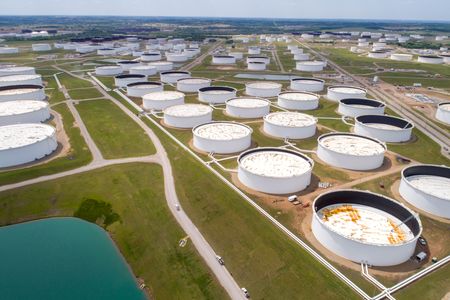By Scott DiSavino
NEW YORK (Reuters) -Oil prices rose 3% to a one-week high on Wednesday as hopes for an improved global economic outlook and concern over the impact of sanctions on Russian crude output outweighed a massive surprise build in U.S. crude stocks.
Brent futures rose $2.57, or 3.2%, to settle at $82.67 a barrel. U.S. West Texas Intermediate (WTI) crude rose $2.29, or 3.1%, to settle at $77.41.
Both benchmarks settled at their highest since Dec. 30, with WTI up for a fifth day in a row for the first time since October and Brent up for a third day in a row for the first time since December.
Global equities were up on hopes that U.S. inflation and earnings figures due on Thursday will indicate a resilient economy and result in a slower pace of interest rate hikes.
If inflation comes in below expectations, that would drive the dollar lower, analysts said, which could boost oil demand because it makes crude cheaper for buyers holding other currencies.
The Federal Reserve will likely hike its target interest rate for the last time at its Jan. 31-Feb. 1 monetary policy meeting, raising it by 50 basis points (bps) to a range of 4.75%-5.00%, HSBC said in a research note.
Much of the market’s optimism was pinned on top oil importer China’s reopening of its economy after the end of strict COVID-19 curbs.
“Energy traders should get used to seeing oil prices head higher. Oil demand is coming back and expectations are high that China’s demand is about to skyrocket,” said Edward Moya, senior market analyst at data and analytics firm OANDA.
China’s overall passenger vehicle sales are estimated to rise 5% in 2023, Volkswagen AG’s China President Ralf Brandstaetter told Chinese media.
China’s industrial output is expected to have grown 3.6% in 2022 from the previous year, the Ministry of Industry and Information Technology (MIIT) said, despite production and logistics disruptions from COVID-19 curbs.
The U.S. Energy Information Administration (EIA) said crude inventories jumped by 19.0 million barrels last week, the third biggest weekly gain ever and the most since stocks rose by a record 21.6 million barrels in Feb 2021. Last week’s increase came as refiners were slow to restore production after a cold freeze shut operations in late 2022.
Analysts polled by Reuters had forecast a 2.2 million-barrel decline in crude stocks, and industry data from the American Petroleum Institute (API) showing a 14.9 million-barrel build. [EIA/S] [API/S]
EIA this week forecast U.S. crude production will reach all-time highs in 2023 and 2024.
An international price cap imposed on sales of Russian crude took effect on Dec. 5 and more curbs aimed at products sales are set to come into force next month as the European Union (EU) keeps working on more sanctions against Moscow over the invasion of Ukraine.
EIA said the upcoming EU ban on seaborne imports of petroleum products from Russia on Feb. 5 could be more disruptive than the EU ban on seaborne imports of crude oil from Russia implemented in December 2022.
Russian Deputy Prime Minister Alexander Novak said the country’s oil producers have had no difficulties in securing export deals despite Western sanctions and price caps.
(Additional reporting by Noah Browning in London, Sonali Paul in Melbourne, Trixie Yap in Singapore and Laila Kearney in New York; Editing by Marguerita Choy, David Goodman and David Gregorio)

